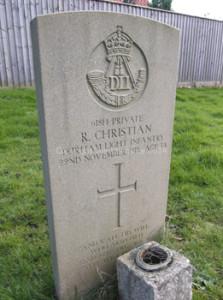
by James | Jan 2, 2015 | Biography
Birth
Name:
Richard Christian
Date of birth:
1884
Date of Birth registration:
Oct-Dec 1884
Place of Birth Registration:
Bourne, Lincolnshire, England
Occupation: Thrashing Machine Driver, Horseman on Farm
Marriage
Wife’s Name:
Kate Maples
Date of Marriage:
Oct-Dec 1913
Place of Marriage:
Bourne District
Wife’s Date of birth:
1889
Wife’s Place of Birth:
Billiingborough
Wife’s father:
Edward Maples
Wife’s Mother:
Elizabeth Francis
Children, (Name), (DOB), (POB):
Harold Christian, Apr-Jun 1914, Bourne District
Ida M Christian, Apr-Jun 1915, Bourne District
Phyllis M Christian, Jan-Mar 1917 Bourne District
Kate Christian, Oct-Dec 1918 Bourne District
Family
Father’s Name:
Robert Christian
Father’s DOB:
1850
Father’s Place of Birth:
Kirkby Underwood, Lincolnshire, England
Father’s Occupation:
Bricklayer
Mother’s Name:
Elizabeth Marshall
Mother’s DOB:
1852
Mothers POB:
Kirkby Underwood, Lincolnshire, England
Mother’s Occupation:
Their Marriage:
1874 Bourne District
Siblings: (Name), (DOB), (POB)
Lucy Christian, 1874, Kirkby Underwood
Sarah Christian, 1877, Kirkby Underwood
Arthur Christian, 1880, Kirkby Underwood
Fred Christian, 1881, Kirkby Underwood
Lizzie Christian, 1883, Kirkby Underwood
Richard Christian, 1884, Kirkby Underwood
Ernest Christian, 1889, Kirkby Underwood
Charles Christian, 1891, Kirkby Underwood
Ethel Ann Christian, 1893, Kirkby Underwood
Harold Christian, 1895, Kirkby Underwood
1891 Census:
Richard is living with his parents in Kirkby Underwood
1901 Census:
Richard is living in Swinstead with Rudkin Family as a Boarder. The census gives him an age of 16 and he is listed as an agricultural horseman on farm.
1911 Census
Richard is living with his mother in Kirkby Underwood.
Richard died in England on the 22nd November 1918, 11 days after the end of the war. Rather than an act of war Richard was the victim of a family tragedy. On the 19th November Richard and Kate became parents for the 4th time when baby Kate was born. Only 3 days later both Richard and his wife Kate died within hours of each other of acute influenza (Spanish Flu being rife at the time) and baby Kate eventually died on the 29th November.
Relatives in services:
Newspaper Mentions
Grantham Journal Saturday 22nd November 1919
Kirkby Underwood
War Memorial Unveiled and Dedicated – Sunday last will live in the memory of all the parishioners and many interested in this little village. The Church services commenced with a celebration of the Holy Eucharist at 8 a.m., followed by matins and sermon at 11 a.m. The special service was at three o’clock and every seat in the church was occupied. Prayers suitable for the occasion were offered by the rector, Rev J.S. Barstow, the special lesson being read by Mr. Wm. Dyson of Bulby Hall, who proceeded after the singing of the hymn, “Stand Up, Stand Up for Jesus” to unveil the beautiful stained glass window, which during the week had been fixed in the east end of the Church. It was then solemnly dedicated by the Rev. Canon Layng – To the Glory of God, and in grateful memory of Bertie Evelyn Rudkin, Ernest Henry Rudkin, Richard Christian and John Thomas Wyer, and as a thankoffering for peace and victory. Mr. Dyson standing on the chancel steps then spoke a few words, which appealed to his hearers. Referring to the long connection of his family with the Church and district, and to the happy days spent in the neighbourhood, he expressed the regret felt by all of them at the coming severance, but trusted that the Church would continue to progress, and believed that the rector, who had served in the late war, was particularly fitted to help and sympathise with his people I their joys and sorrow . The window he regarded as the most beautiful war memorial and he was highly pleased with it. A few well-chosen, comforting words were addressed to the parents and relatives of the fallen, reference being made to the powers given to the laity by the Enabling Bill, and all were urged to work for the Church, rather than for this or that particular incumbent; and lastly referring to the present industrial unrest, he expressed his confidence that the good sense and judgment of the people would prevail and all classes work together for the general good. The Hymn, “For All The Saints” was feelingly sung, and the memorable service concluded by the “Last Post” sounded by Sergt. Pattinson of Bourne. In the evening, a memorial service was held in the honour of the fallen. The Rector took as his text the words inscribed on the window, “I am the Resurrection and the Life.” He clearly explained the idea underlying the window, and connecting the various figures on it, and its special appropriateness to the Church and as a memorial.. A Glowing tribute was paid to the courage and unselfishness of those who had given their lives that we may live, and for King and Country, and words of sympathy and hope addressed particularly to the mourners present, as one who was a mourner himself a mourner. The Late Rector, the Rev. W.H. Langworthy (The present rector of Claypole) organized the idea of the window as a war memorial, and worked hard for its accomplishment, but was unable to be present at the dedication.
Military Records
Attestation Papers:
Available for 1902 for the Lincolnshire Regiment
WW1 Soldier’s Records:
Soldier’s Died In The Great War:
Not found
Pension Records:
Not yet available
Medals
Medal Card Index:
Richard’s medal card index states that he was eligible for the following medals:-
The British Medal
The Victory Medal
Memorials
UK:
Kirkby Underwood, plaque in St Mary and All Saints Church
Kirkby Underwood, Names on the stained glass window in St Mary and All Saints Church
Commonwealth War Graves Commission:
In Memory of Private R Christian, 61814, Durham Light Infantry who died on 22 November 1918 Age 34
Son of Elizabeth Christian, of Kirkby Underwood, Lincs and the late Robert Christian; husband of the late Kate Christian
Remembered with Honour, Billingborough (St Andrews) Churchyard
More information:
Military Service Timeline
Richard attested to the militia of the 4th Lincolnshire Regiment on the 22nd May 1902 and was living in Billingborough.
Richard drilled with the 4th Battalion Lincolnshire regiment until April 1908 when he was discharged when the Territorial and Reserve Forces act disbanded the volunteer and militia units and placed the men on regular army reserve.
Richard joined the Durham Light Infantry (61814) during the war although the date is not known.
He was later transferred to the 409th Company of the labour Corps with a change of regimental number to 19310. The 409th company was known as the Kesteven and Lindsay company which was based at Lincoln. The labour Corps traditionally took men who were wounded and then classed as less than A1 fitness and this would indicate that Richard was either wounded or, at the age of 34 not fit for front line service.
Men of the labour corps were traditionally commemorated by the CWGC under their original regiment and number.
Richard died in England on the 22nd November 1918, 11 days after the end of the war. Rather than an act of war Richard was the victim of a family tragedy. On the 19th November Richard and Kate became parents for the 4th time when baby Kate was born. Only 3 days later both Richard and his wife Kate died within hours of each other of acute influenza (Spanish Flu being rife at the time) and baby Kate eventually died on the 29th November.

by James | Jan 2, 2015 | Biography
http://www.jamieandsue.co.uk/?page_id=268
Birth
The birth of Arthur Ashton was registered in the March Quarter in Bourne 1896. Research into his army records shows his age as 19 years and 7 months on the 4th September 1914 indicating a birth in either January or early February 1895. Here we have a discrepancy of one year but as the Birth Registration should take place within three months then we have to assume that he was born in 1896.
Family History
Arthur Ashton was born in Dunsby, Lincolnshire, England to Cornelius Ashton, a cattleman on a farm and his wife Alice Boyfield. Cornelius was born in Morton and after his marriage to Alice Boyfield in 1891 lived there before moving to Dunsby.
The children of Cornelius and Alice were:-
Hilda b c1894, Cornelius b c1895, Arthur b 1896, Frederick Victor (aka Victor) b c1897, Evelyn Mary (aka Eva) b c1899 and Alice b 1901.
Cornelius Ashton died in 1901 and it is thought that his wife Alice died in 1905.
In 1911 Arthur is listed on the census for Morton as living with his Uncle Arthur Ashton, Aunt Kate and their children Bernard and Myra.
In September 1914 Arthur had listed his address as “Care Of Mrs Pace, Belper, Derbyshire”.
In May 1919 the army wrote to an Arthur and Kate Ashton of Tower House Morton, Bourne to ascertain kinship of the close relatives of Arthur. This Arthur was an Uncle who filled out a form which shows none for the father and mother and lists Arthur’s brothers and sisters as listed above. Alice Ashton was living with her Aunt and Uncle in May 1919.
Cornelius, Arthur’s Brother also served in the Great War with the 7th Durham.
Arthur’s Cousin John Thomas Ashton is also remembered on the Morton Memorial having been killed in action in April 1917
Military History
In August 1914 the 1/5th Battalion Sherwood Foresters were formed in Derby as part of Notts. & Derby Brigade and in the North Midland Division.
The Commonwealth war Graves Commission has some basic information and shows the enlistment location for Arthur Ashton as Morton. I am not sure if this is correct as his attestation records list an address in Derbyshire which would be consistent with his enlistment into the Nottinghamshire and Derbyshire Regiment, The Sherwood foresters.
On the 4th September 1914 Arthur enlisted for the Territorial Force at Derby at the age of 19 years and 7 months. This was only six weeks after war had been declared and his attestation papers show that he had no previous military service.
Arthur passed his medical examination and was described as “fit” his description shows that he was 5 feet 9 ½ inches and had a chest of 36 inches. At this point he was assigned to the 5th battalion Notts and Derby Regiment.
Upon mobilisation the 5th Battalion was moved to Harpenden and in November 1914 went on to Braintree for training.
By February 1915 the battalion was ready for action and moved to Southampton to be shipped to France, where they landed at Harve on the 25th February. The Battalion was part of the first complete territorial force to link up with the British Expeditionary Force.
On the12th of May 1915 the formation of the 5th, 6th, 7th and 8th Battalions became known as the 139th(forester) Brigade in the 46th (North Midland) Division.
On the 15th August 1915 Arthur Ashton was wounded in his right thigh and records show he was admitted at Abeele.
The place mentioned in the report, Abeele, is a small village bisected by the border between France and Belgium. This was the site of a WW1 military airfield and we can only assume that this would be a location of Billets and possibly a military hospital. There is another entry on Arthur’s military records showing that on the 4th September 1915 he was mentioned in a report from a different source but again this mentions that he was admitted at Abeele on the 16th August 1915.
By 22nd October 1915 Arthur was passed as fit for service and was sent back to duty in the field.
The maps above show the movements of the Sherwood Foresters during the tour of the front line when Arthur Ashton died. On the 6th November 1915, the 5th Battalion Sherwood Foresters started a tour and took to the trenches on the right sub-sector of the front line, south of Richbourg-L’Avoue, setting up headquarters in Albert Road. Two companies were placed in the front line, one in support and one in reserve, a position they were to hold until being relieved on the 10th November.
Arthur saw his final action on the 7th of November 1915 when he was killed by a sniper aged 19. His brother Neal (Cornelius is reported to have written home saying that he believed that Arthur of the same battalion had been shot).
Private Arthur Ashton 2402, 1/5th Battalion Sherwood Foresters (Notts and Derby Regiment) was eligible for the following medals:-
Victory Medal
The British Medal
The 1915 Star.
Newspaper Articles
Grantham Journal 31st October 1914
Off to the front – On Sunday afternoon, the people of Morton gave Arthur Ashton a good “Send-off” on his way to Essendine Station, en route to the headquarters of his regiment preparatory to joining the Expeditionary Force in France. Arthur, who joined the Regulars (the 5th Notts and Derby Regiment) only two months ago, is quite elated at being able to serve his country soon. His brother Cornelius, also a Morton man, joined the 6th Notts and Derbys. Arthur Ashton is an old chorister of Morton Church, and on Sunday his colleagues met to wish him “God speed and a safe return”. A collection was made among the members of the choir and friends gathered round at the cross-roads at the time fixed for Arthur’s departure, and a large box of cigarettes and a new purse containing a sovereign were hastily collected and given to him.
Grantham Journal November 27th 1915
For King and Country – We regret to state that Arthur Ashton, a Morton Soldier, has been shot by a sniper. His Brother Neal Ashton, in the same Battalion, sent the sad news. Whether the shot was fatal or otherwise, his numerous friends in Morton are very anxious to learn. We understand that no official notification of his death has been received. Another name has been added to the Roll of Honour, Edwin Handford having joined the Lincolnshire Regiment.
Grantham Journal 11th December 1915
Sad news has been received at Morton within the past few days that two of her gallant youths have laid down their lives for their country. In a previous issue, we reported that a letter had been received from Pte C Ashton, who is in France, to the effect that he was afraid that his brother Arthur had been shot by a German sniper. Upon inquiry at the War Office, the news has been officially proved to be only too true. The Parents of Thomas Fowler received a communication last week stating that their son was killed by a gunshot wound in the shoulder. He was drafted with a Mediterranean Force and death took place at Sulva on the Gallipoli Peninsula. Real heart-felt sympathy is felt for the bereaved families. Our toll of the war is now seven and we share the unenviable distinction of figuring most conspicuously in the casualty lists which concern the villages in the Bourne district. On Sunday evening last, the Parish Church was packed with parishioners who came to pay their last tributes to the three brave lads – Arthur Ashton, Thomas Fowler, Joseph Taylor (who was recently killed by a trench mortar in France). The Vicar, the Rev J.H. Boldero, read the burial service only omitting the committal portion. The lesson for the day was singularly appropriate vis., St John xiv. “Let not your heart be troubled, ”which was read by the schoolmaster, Mr. J.W. Palmer. In the course of the sermon, the vicar made a touching reference to the three lads, mentioning that they were all members of the church, and had all been in the church choir, and how, when far away, their last thoughts had been of home and the old church. The rev. gentleman spoke words of great comfort to the bereaved. The sadness was on all; the congregation mourned with the parents of the dead soldiers. At the close of the service, the National Anthem was sung, and the “Dead March” in “Saul” was played by the organist (Miss Betson). It was a beautiful service, and one that will long be remembered and the vicar’s words were most uplifting.
Memorial
Private Arthur Ashton 2402 is remembered with honour at the Rue-Des-Berceaux Military Cemetery at Richebourg-L’Avoue near Bethune in the Nord-Pas-De-Calais region of France. Reference II. F. 1.




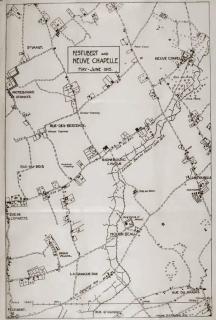
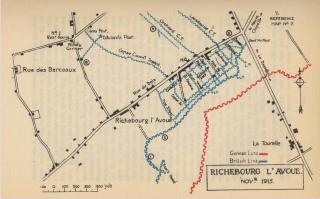
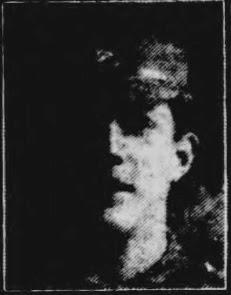
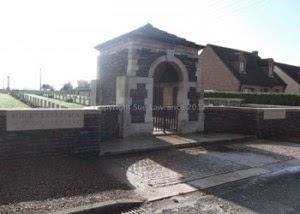
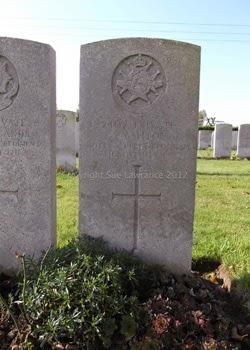
Recent Comments